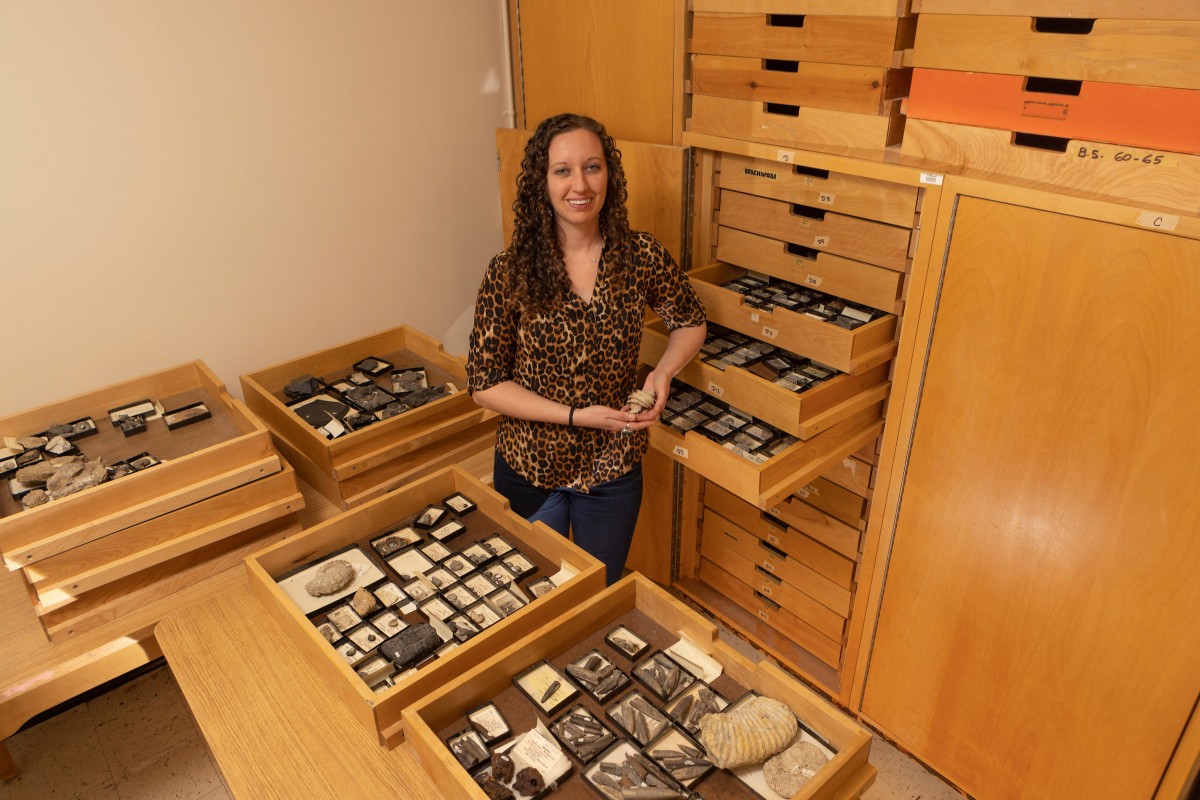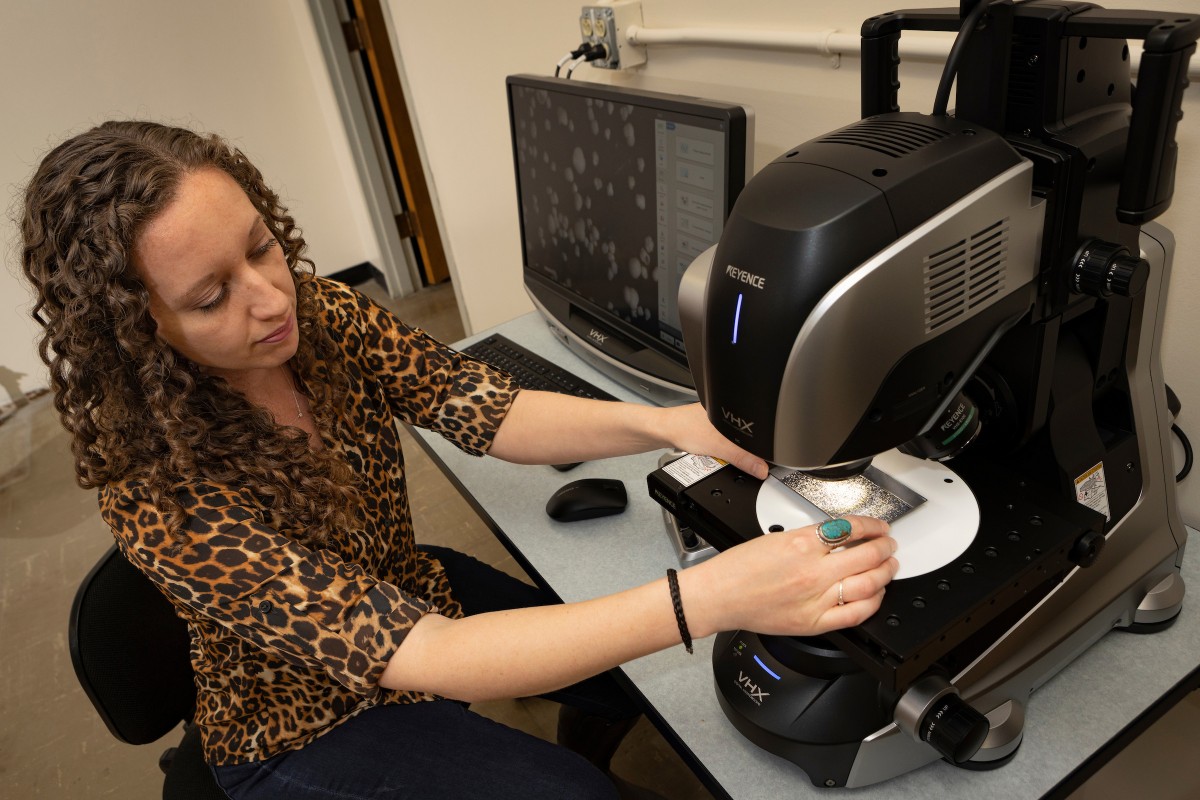Research currents: What tiny fossils can tell us about the changing climate
By studying ancient seas, paleontologist and paleoceanographer Adriane Lam charts our climate change future

Adriane Lam’s research allows scientists to more accurately predict future climate and zoological changes as the Earth continues to warm.
Lam, a paleontologist and paleoceanographer, is an assistant professor in Harpur College’s Earth Sciences Department, but she was raised in a rural town in Hanover County, Va. Its location deep in the state’s backwoods aided Lam in her first scientific explorations: She collected rocks and animal skulls and learned how to distinguish between mineral types.
Now she studies a group of marine plankton called planktic foraminifera that live in the surface ocean. Foraminifera secrete a calcium carbonate shell, and when they die those shells collect in layers on the sea floor over millions of years. Lam’s goal is to date the sediments using the first and last occurrences of certain species of foraminifera preserved in the fossil record. This process is known as biostratigraphy.
Using the fossil plankton shells, researchers can reconstruct oceanic conditions across ancient warm periods to predict how Earth’s systems will react to climate change. For example, by looking at the Mid-Piacenzian Warm Period, which took place about 3.3 million years ago, researchers found that there was almost as much carbon dioxide in the atmosphere then as there is now.
“With the chemistry of their [foraminifera] tests, we can actually infer things about climate change such as water temperatures, salinity changes, ice volume changes and also productivity changes in the water column through time,” Lam says.
Biostratigraphers normally rely on a particular scheme to tell the age of the rocks, but Lam realized that it was not universally applicable.
Plankton are migratory by nature and move to other areas over large spans of time. Therefore, her lab has been focused on creating more- nuanced schemes for telling time with the fossil plankton in different areas of the ocean.
Lam has zoomed in on the foraminifera of the southwestern Pacific Ocean’s mid-latitude region. She’s using the geochemistry of the plankton to reconstruct surface water temperature, salinity values and more.
The work is an extension of postdoctoral research Lam began at Binghamton as well as a continuation of her dissertation project. She earned her doctorate at the University of Massachusetts, Amherst in geosciences; that’s also where she was when she went on her first ocean expedition. After an extensive application process to board the ship, selected researchers work 12 hours a day while at sea for two months straight.
To Lam, it isn’t a bad trade. Scientists put in long days at sea, but daily tasks such as cooking, cleaning and laundry were taken care of by the crew. Many of Lam’s experiments are sourced from underwater sediment cores that she and her research team obtained during this trip.
“One of the most vivid memories from sailing in the Tasman Sea is going out onto the deck at night and looking up at the sky,” Lam recalls. “I’ve never seen the sky so clear. There’s no light pollution, and you can see the Milky Way stretching across the entire sky. It is breathtaking.”
For her dissertation research, Lam reconstructed the Kuroshio Current Extension, a western boundary current that supplies warmth to waters near Japan, and helps support a wide diversity of marine life. She wanted to observe the behavior of foraminifera as the Kuroshio’s warm waters met with the Arctic’s cold currents, creating a transitory area of warm and cool water species called an ecotone. More specifically, she wanted to quantify how many species were able to sustain life in the now-temperate waters.
“One of the papers we published found that actually, for the last at least 12 million years, there’s very high diversity within the Kuroshio Current Extension throughout this time period,” Lam says. “And we think that means two things: One, that this current has sustained planktic foraminifera for a really long time in that region. Two, that the Kuroshio Current Extension’s ecotone has been a prevalent feature in the Northwest Pacific for a very long time.”
Lam was interested to learn that foraminifera showed a greater diversity at 37° north latitude, which is much higher than the field’s previously predicted latitude at which foraminiferal diversity peaks.
“This is called the latitudinal diversity gradient, and a lot of biological studies say that the tropics hold the highest diversity of organisms — that’s not true for all species,” Lam says. “So our study found that the latitudinal diversity gradient for foraminifera may actually be a little different. … We were showing higher diversity at higher latitudes.”
Although Lam loves research, the coolest part of her job has been teaching students all about her passion: geology. Lam has a special message she likes to leave with all of her students throughout their time together.
“My first comment is: You belong, everyone belongs,” says Lam, who was a first-generation college student. “Academia may not have been made for everyone at first, but it surely is today. The second piece of advice I have is to find mentors — not just advisors; find mentors. These are people who are going to help you along in your career. It’s just finding people you can rely on, that you can vent to. That will give you good advice and support you, no matter what.”

